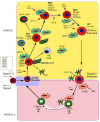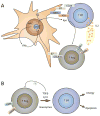Immune tolerance and transplantation
- PMID: 23206840
- PMCID: PMC3514882
- DOI: 10.1053/j.seminoncol.2012.10.001
Immune tolerance and transplantation
Abstract
Successful allogeneic hematopoietic stem cell transplantation (HSCT) and solid organ transplantation require development of a degree of immune tolerance against allogeneic antigens. T lymphocytes play a critical role in allograft rejection, graft failure, and graft-versus-host disease (GVHD). T-cell tolerance occurs by two different mechanisms: (1) depletion of self-reactive T cells during their maturation in the thymus (central tolerance), and (2) suppression/elimination of self-reactive mature T cells in the periphery (peripheral tolerance). Induction of transplant tolerance improves transplantation outcomes. Adoptive immunotherapy with immune suppressor cells including regulatory T cells, natural killer (NK)-T cells, veto cells, and facilitating cells are promising therapies for modulation of immune tolerance. Achieving mixed chimerism with the combination of thymic irradiation and T-cell-depleting antibodies, costimulatory molecule blockade with/without inhibitory signal activation, and elimination of alloreactive T cells with varying methods including pre- or post-transplant cyclophosphamide administration appear to be effective in inducing transplant tolerance.
Copyright © 2012 Elsevier Inc. All rights reserved.
Figures



References
-
- Sykes M. Immune tolerance: mechanisms and application in clinical transplantation. Journal of internal medicine. 2007;262:288–310. - PubMed
-
- Mueller DL. Mechanisms maintaining peripheral tolerance. Nature immunology. 2010;11:21–7. - PubMed
-
- Igarashi H, Gregory SC, Yokota T, Sakaguchi N, Kincade PW. Transcription from the RAG1 locus marks the earliest lymphocyte progenitors in bone marrow. Immunity. 2002;17:117–30. - PubMed
-
- Adolfsson J, Mansson R, Buza-Vidas N, et al. Identification of Flt3+ lympho-myeloid stem cells lacking erythro-megakaryocytic potential a revised road map for adult blood lineage commitment. Cell. 2005;121:295–306. - PubMed
Publication types
MeSH terms
Grants and funding
LinkOut - more resources
Full Text Sources
Other Literature Sources
Medical
Research Materials

